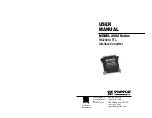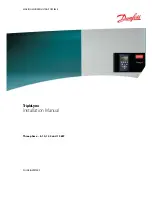
PRINCIPLE OF OPERATION
The transducer is a force balance device in which a coil is suspended in the field of a magnet by a flexure. Current flowing
through the coil generates axial movement of the coil and flexure. The flexure moves against the end of a nozzle, and creates
a back pressure in the nozzle by restricting air flow. This back pressure acts as a pilot pressure to an integral booster relay.
Consequently, as the input signal increases (or decreases, for reverse acting), output pressure increases proportionally.
Zero and span are calibrated by turning easily accessible adjusting screws on the front face of the unit. The zero adjustment
causes the nozzle to move relative to the flexure. The span adjustment is a potentiometer that limits the flow of current
through the coil. A thermistor circuit in series with the coil provides temperature compensation.
MOUNTING
The transducer can be mounted at any angle, but should be
calibrated after mounting. For maximum output pressure
stability, it should be mounted vertically in a vibration free
location or such that the vibration is isolated to the X and Z
axis as shown in
Figure 3
.
Pipe:
Due to its light weight , the transducer may be sup-
ported by the piping used for the supply and output.
Panel:
(with access to rear of panel) Attach transducer
(
See Fig. 3
), to panel using two 10-32 screws and two
threaded mounting holes on the back of the unit.
Panel:
(with no access to rear of panel) Attach bracket
(
see Fig 1 and 3
), to transducer using two 10-32 screws
on the back of the unit and mount bracket to panel using
four 8-32 screws.
AIR CONNECTIONS
•
Supply Air must be instrument quality air regulated
between the minumum and maximum specified on the
nameplate of the transducer.
•
Instrument quality air consists of :
a A dew point less than 35˚F
b No particles larger than three microns
c Maximum oil content of 1 ppm
•
All unused ports must be plugged.
Supply:
Connect supply to the1/4" NPT ports marked “IN” on the base of the transducer. Avoid getting pipe sealant inside
the piping or transducer.
Output:
Connect output to the 1/4" NPT ports marked “OUT” on the base of the transducer. The pipe plugs may be removed
from the two auxiliary output ports for a pressure gauge or as an alternative output port.
M4110/
IP211, EP211 SERIES
0519
A
3
Figure 1
Содержание IP211 Series
Страница 8: ...M4110 0519 IP211 EP211 SERIES A 8 Figure 3...




























